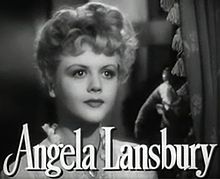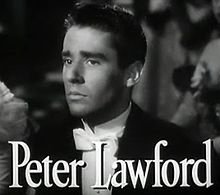fiction.wikisort.org - Movie
The Picture of Dorian Gray is a 1945 American horror-drama film based on Oscar Wilde's 1890 novel of the same name. Released in June 1945 by Metro-Goldwyn-Mayer, the film is directed by Albert Lewin, and stars George Sanders as Lord Henry Wotton and Hurd Hatfield as Dorian Gray. Shot primarily in black-and-white, the film features four colour inserts in three-strip Technicolor of Dorian's portrait; these are a special effect, the first two inserts picturing a youthful Dorian and the second two a degenerate one.
| The Picture of Dorian Gray | |
|---|---|
 Promotional poster | |
| Directed by | Albert Lewin |
| Screenplay by | Albert Lewin |
| Based on | The Picture of Dorian Gray 1891 novel by Oscar Wilde |
| Produced by | Pandro S. Berman |
| Starring | George Sanders Hurd Hatfield Donna Reed Angela Lansbury Peter Lawford Lowell Gilmore |
| Narrated by | Cedric Hardwicke |
| Cinematography | Harry Stradling |
| Edited by | Ferris Webster |
| Music by | Herbert Stothart |
| Color process | Technicolor |
Production company | Metro-Goldwyn-Mayer |
| Distributed by | Loew's Inc. |
Release date |
|
Running time | 110 minutes[2] |
| Country | United States |
| Language | English |
| Budget | $1,918,000[3] |
| Box office | $2,975,000[3][4] |
Plot
While posing for a painting by his friend Basil Hallward, handsome young aristocrat Dorian Gray meets Hallward's friend Lord Henry Wotton. Wotton persuades Gray the only worthwhile life is dedicated to pleasure, because "what the gods give they quickly take away." Contemplating this, Gray wishes his portrait could age instead of him. He makes this wish in the presence of an Egyptian cat statue with supposed magical powers.

After callously breaking off his engagement to tavern singer Sibyl Vane, Gray finds the portrait has begun to change and wonders if his wish may have come true. He has the portrait locked away in his old schoolroom and disguises its location by firing servants who moved the painting, while Gray becomes more dedicated to a sinful and heartless life.


Years later, Dorian is 40 but still looks 22. London society is awestruck at his unchanging appearance. The portrait has remained locked away, with Gray holding the only key. Over the years, the portrait of the young, handsome, Dorian Gray has warped into a hideous, demon-like creature reflecting his many sins. When Hallward sees his painting, Gray murders his friend and seals his body in the school room next to the portrait, then blackmails his friend, Allen Campbell, to dispose of Hallward's body. Campbell, distraught at his role in destroying Hallward's corpse, commits suicide.
Gray starts a romance with Hallward's niece, Gladys. James Vane, Sibyl's brother, follows Gray to his country estate to achieve revenge for Sibyl's death and is shot by accident during a hunting party.
Gray despairs at his impact on others and realises he can spare Gladys from misfortune by leaving her. After sending Gladys a letter breaking their engagement, Gray confronts his portrait and sees a subtle improvement. He stabs the portrait in the heart, seeking to end the spell, but cries out as if he has also been stabbed. His friends, realizing what has happened, burst into the schoolroom to discover Gray dead next to the portrait, his deformed body now reflecting his sins in physical form. The portrait, by contrast, once more shows Dorian Gray as a young, innocent man.
Cast
- George Sanders as Lord Henry Wotton
- Hurd Hatfield as Dorian Gray
- Donna Reed as Gladys Hallward
- Angela Lansbury as Sibyl Vane
- Peter Lawford as David Stone
- Lowell Gilmore as Basil Hallward
- Richard Fraser as James Vane
- Douglas Walton as Allen Campbell
- Morton Lowry as Adrian Singleton
- Miles Mander as Sir Robert Bentley
- Lydia Bilbrook as Mrs. Vane
- Mary Forbes as Lady Agatha
- Robert Greig as Sir Thomas
- Moyna Macgill as Duchess
- Anita Sharp-Bolster as Lady Harborough
- Billy Bevan as Malvolio Jones
- Lilian Bond as Kate
Uncredited Cast
- Cedric Hardwicke as Narrator
- Mitchell Lewis as Waiter
- Reginald Owen as Lord George Farmour
Production
This section needs expansion. You can help by adding to it. (October 2022) |
Differences between movie and book
Changes to the original include the romance between Gladys and David and “some censorship restrictions that kept Dorian's unspeakable acts offscreen.” [5] In the book, the picture alters in response to Dorian's "good deed", but the alteration is ugly, reflecting his cynicism and self-serving motivation. He stabs the painting to destroy his conscience and eliminate the evidence. In the film, he reads a faint change in the painting as a sign of hope, yet stabs the painting as if he can undo his past. As he is transformed off-screen, he prays for forgiveness.[6]
The paintings

| External audio | |
|---|---|
Two paintings of the character Dorian Gray were used in the film. The painting titled Picture of Dorian Gray[7] used at the end of the film was painted on commission during the making of the film in 1943-1944 by Ivan Le Lorraine Albright, an American artist who was well known as a painter of the macabre. Created specifically for use in the film, it is now part of the art collection of the Art Institute of Chicago. Albright painted and altered the picture while the movie was being made to allow it to represent the development of Dorian's character.[citation needed]
The portrait of Dorian Gray seen in the beginning of the film was painted by Henrique Medina, and is titled Portrait of Hurd Hatfield as Dorian Gray. It was originally sold at an MGM auction in 1970 when the contents of the studio were sold at a series of auctions lasting several months. It was then sold in a Butterfield and Butterfield Entertainment Memorabilia auction in 1997 for $17,250,[8] and in 2015 it was sold at Christie's, New York, for $149,000 and is believed to be in a private collection.[9][10]
Music
The first piano piece played by Dorian to Sibyl is Frédéric Chopin's "Prelude No 24 in D minor". Played later in the Blue Gate Field house is Ludwig van Beethoven's "Moonlight Sonata".
Box office
According to MGM records, the film earned $1,399,000 in the U.S. and Canada and $1,576,000 elsewhere, resulting in a loss of $26,000.[3]
Awards and nominations
This section needs additional citations for verification. (November 2016) |
| Year | Award | Result | Category | Recipient |
|---|---|---|---|---|
| 1946 | Academy Award | Nominated | Best Art Direction-Interior Decoration, Black-and-White | John Bonar, Cedric Gibbons, Hugh Hunt, Hans Peters and Edwin B. Willis |
| Nominated | Best Actress in a Supporting Role | Angela Lansbury | ||
| Won | Best Cinematography, Black-and-White | Harry Stradling[lower-alpha 1] | ||
| Golden Globe Award | Won | Best Supporting Actress | Angela Lansbury | |
| 1996 | Hugo Award | Won | Best Dramatic Presentation | Albert Lewin, Oscar Wilde |
| 2009 | Saturn Award | Nominated | Best DVD Classic Film Release | The Picture of Dorian Gray |
- AFI's 100 Years...100 Thrills – No. 86
- AFI's 100 Years...100 Heroes and Villains:
- Dorian Gray — Nominated Villain
See also
- Adaptations of The Picture of Dorian Gray
Notes
- This Oscar win for Cinematography is a rare demonstration of respect for a horror film.[11]
References
- "The Picture of Dorian Gray (1945)", catalog, American Film Institute (AFI), Los Angeles, California. Retrieved November 5, 2020.
- "THE PICTURE OF DORIAN GRAY (A)". British Board of Film Classification. 1945-04-04. Retrieved 2022-10-02.
- The Eddie Mannix Ledger, Los Angeles: Margaret Herrick Library, Center for Motion Picture Study.
- Scott Eyman, Lion of Hollywood: The Life and Legend of Louis B. Mayer, Robson, 2005 p 337
- "The Picture of Dorian Gray". www.tcm.com. Retrieved 2022-10-04.
- "The Picture of Dorian Gray". www.tcm.com. Retrieved 2022-10-04.
- Information about Picture of Dorian Gray in the Art Institute of Chicago
- Tribune, Danielle Arnet Special to the. "MERGER MANIA HITS THE AUCTION CIRCUIT". chicagotribune.com. Retrieved 2020-05-13.
- "Lot 1330 Henrique Medina (1901-1988) Portrait of Hurd Hatfield as Dorian Gray". Christie's. 21 March 2015. Retrieved 12 November 2018.
- "Henrique Medina, Cindy Sherman | "Portrait of Hurd Hatfield as Dorian Gray" and "The Evil Twin" (1945 and 2016) | Artsy". www.artsy.net. Retrieved 2020-05-13.
- Vieira, Mark A. (2003). Hollywood Horror: From Gothic to Cosmic. New York: Harry N. Abrams, Inc. p. 117. ISBN 0-8109-4535-5.
External links
- The Picture of Dorian Gray at IMDb
- The Picture of Dorian Gray at the TCM Movie Database
- The Picture of Dorian Gray at AllMovie
- The Picture of Dorian Gray at the American Film Institute Catalog
- The Picture of Dorian Gray at Rotten Tomatoes
На других языках
[de] Das Bildnis des Dorian Gray (1945)
Das Bildnis des Dorian Gray (Originaltitel: The Picture of Dorian Gray) ist ein US-amerikanischer Film von Albert Lewin aus dem Jahr 1945. Er basiert auf dem gleichnamigen Roman von Oscar Wilde. In Deutschland wurde er am 3. Februar 1950 erstmals gezeigt.- [en] The Picture of Dorian Gray (1945 film)
[ru] Портрет Дориана Грея (фильм, 1945)
«Портрет Дориана Грея» (англ. The Picture Of Dorian Gray) — кинофильм режиссёра Альберта Левина, вышедший в 1945 году. Экранизация одноимённого романа Оскара Уайльда, которая является самой известной из всех. Исполнительница роли Сибилы Вэйн Анджела Лэнсбери получила награду Голливудской ассоциации иностранной прессы «Золотой глобус» и номинацию на премию Американской академии «Оскар» в категории «Лучшая актриса второстепенной роли».Другой контент может иметь иную лицензию. Перед использованием материалов сайта WikiSort.org внимательно изучите правила лицензирования конкретных элементов наполнения сайта.
WikiSort.org - проект по пересортировке и дополнению контента Википедии